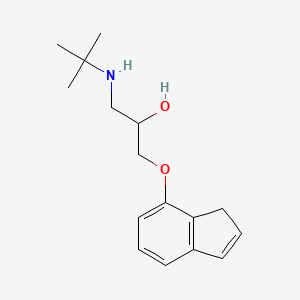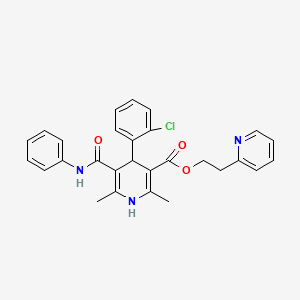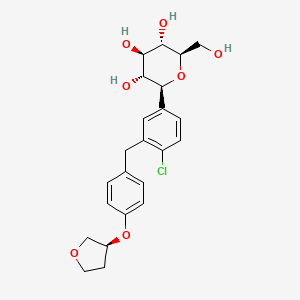
エンパグリフロジン
概要
説明
エンパグリフロジンは、主に2型糖尿病の管理に使用される経口薬です。これは、ナトリウム-グルコース共輸送体2(SGLT2)阻害剤として知られる薬剤のクラスに属します。SGLT2を阻害することにより、エンパグリフロジンは腎臓におけるグルコースの再吸収を減らし、尿中へのグルコース排泄を増加させます。 これは、2型糖尿病の患者における血糖値を下げるのに役立ちます .
2. 製法
合成経路と反応条件: エンパグリフロジンは、いくつかの重要な中間体を伴う複数段階のプロセスによって合成されます。一般的な合成経路の1つは、以下の手順を含みます。
中間体Iの形成: 最初のステップでは、4-クロロ-3-(4-(テトラヒドロフラン-3-イルオキシ)ベンジル)フェニルと適切なグルコシルドナーを反応させて、中間体Iを形成します。
中間体IIの形成: 中間体Iは、保護および脱保護ステップを含むさらなる反応を受けて、中間体IIになります。
最終的なカップリング: 次に、中間体IIを適切なグルコシルドナーと塩基性条件下でカップリングさせて、エンパグリフロジンを形成します
工業的製造方法: エンパグリフロジンの工業的製造は、通常、高収率と純度を確保するために最適化された反応条件を使用して、大規模合成を行います。このプロセスには以下が含まれます。
還流: 反応混合物を還流させて、所望の生成物の形成を促進します。
科学的研究の応用
Empagliflozin has a wide range of scientific research applications, including:
Diabetes Management: Empagliflozin is primarily used to manage type 2 diabetes by lowering blood sugar levels
Cardiovascular Benefits: Research has shown that empagliflozin can reduce the risk of cardiovascular events, such as heart attacks and strokes, in patients with type 2 diabetes
Renal Protection: Empagliflozin has been found to have nephroprotective effects, reducing the risk of kidney disease progression.
Heart Failure: The compound is also used to treat heart failure, providing benefits beyond glucose control.
作用機序
エンパグリフロジンは、腎臓におけるナトリウム-グルコース共輸送体2(SGLT2)を阻害することで効果を発揮します。この阻害は、糸球体濾過液からのグルコースの再吸収を減らし、尿中へのグルコース排泄を増加させます。血糖値の低下は、2型糖尿病の管理に役立ちます。 さらに、エンパグリフロジンは、酸化ストレスの軽減や内皮機能の改善などのメカニズムを介して、心臓保護および腎臓保護効果があることが示されています .
準備方法
Synthetic Routes and Reaction Conditions: Empagliflozin is synthesized through a multi-step process involving several key intermediates. One common synthetic route involves the following steps:
Formation of Intermediate I: The initial step involves the reaction of 4-chloro-3-(4-(tetrahydrofuran-3-yloxy)benzyl)phenyl with a suitable glucosyl donor to form Intermediate I.
Formation of Intermediate II: Intermediate I undergoes further reactions, including protection and deprotection steps, to yield Intermediate II.
Final Coupling: Intermediate II is then coupled with a suitable glucosyl donor under basic conditions to form empagliflozin
Industrial Production Methods: Industrial production of empagliflozin typically involves large-scale synthesis using optimized reaction conditions to ensure high yield and purity. The process includes:
Refluxing: The reaction mixture is refluxed to facilitate the formation of the desired product.
Purification: The crude product is purified using techniques such as recrystallization and chromatography to obtain empagliflozin with high purity
化学反応の分析
反応の種類: エンパグリフロジンは、以下を含むさまざまな化学反応を起こします。
一般的な試薬と条件:
酸化分解: 過酸化水素などの試薬や他の酸化剤は、酸化分解を誘発する可能性があります。
形成される主要な生成物:
酸化分解生成物: 使用される特定の条件と試薬に応じて、さまざまな酸化生成物が形成される可能性があります。
加水分解生成物: 加水分解は、より小さな断片と分解生成物の形成につながる可能性があります.
4. 科学研究への応用
エンパグリフロジンは、以下を含む幅広い科学研究への応用を持っています。
類似化合物との比較
エンパグリフロジンは、SGLT2阻害剤のクラスの薬剤の1つです。このクラスの他の類似した化合物には、以下が含まれます。
カナグリフロジン: 2型糖尿病の管理に使用される別のSGLT2阻害剤。
ダパグリフロジン: この化合物は、2型糖尿病の治療にも使用され、心不全の治療にも承認されています.
エルツグリフロジン: 作用機序は類似していますが、薬物動態特性が異なる別のSGLT2阻害剤.
エンパグリフロジンのユニークさ: エンパグリフロジンは、SGLT1よりもSGLT2に対して高い選択性を持ち、その有効性と安全性プロファイルに貢献しています。 また、心血管および腎臓の利点が大きく、2型糖尿病と併存症を持つ患者にとって貴重な選択肢となっています .
特性
IUPAC Name |
(2S,3R,4R,5S,6R)-2-[4-chloro-3-[[4-[(3S)-oxolan-3-yl]oxyphenyl]methyl]phenyl]-6-(hydroxymethyl)oxane-3,4,5-triol | |
|---|---|---|
| Source | PubChem | |
| URL | https://pubchem.ncbi.nlm.nih.gov | |
| Description | Data deposited in or computed by PubChem | |
InChI |
InChI=1S/C23H27ClO7/c24-18-6-3-14(23-22(28)21(27)20(26)19(11-25)31-23)10-15(18)9-13-1-4-16(5-2-13)30-17-7-8-29-12-17/h1-6,10,17,19-23,25-28H,7-9,11-12H2/t17-,19+,20+,21-,22+,23-/m0/s1 | |
| Source | PubChem | |
| URL | https://pubchem.ncbi.nlm.nih.gov | |
| Description | Data deposited in or computed by PubChem | |
InChI Key |
OBWASQILIWPZMG-QZMOQZSNSA-N | |
| Source | PubChem | |
| URL | https://pubchem.ncbi.nlm.nih.gov | |
| Description | Data deposited in or computed by PubChem | |
Canonical SMILES |
C1COCC1OC2=CC=C(C=C2)CC3=C(C=CC(=C3)C4C(C(C(C(O4)CO)O)O)O)Cl | |
| Source | PubChem | |
| URL | https://pubchem.ncbi.nlm.nih.gov | |
| Description | Data deposited in or computed by PubChem | |
Isomeric SMILES |
C1COC[C@H]1OC2=CC=C(C=C2)CC3=C(C=CC(=C3)[C@H]4[C@@H]([C@H]([C@@H]([C@H](O4)CO)O)O)O)Cl | |
| Source | PubChem | |
| URL | https://pubchem.ncbi.nlm.nih.gov | |
| Description | Data deposited in or computed by PubChem | |
Molecular Formula |
C23H27ClO7 | |
| Source | PubChem | |
| URL | https://pubchem.ncbi.nlm.nih.gov | |
| Description | Data deposited in or computed by PubChem | |
DSSTOX Substance ID |
DTXSID601026093 | |
| Record name | Empagliflozin | |
| Source | EPA DSSTox | |
| URL | https://comptox.epa.gov/dashboard/DTXSID601026093 | |
| Description | DSSTox provides a high quality public chemistry resource for supporting improved predictive toxicology. | |
Molecular Weight |
450.9 g/mol | |
| Source | PubChem | |
| URL | https://pubchem.ncbi.nlm.nih.gov | |
| Description | Data deposited in or computed by PubChem | |
Mechanism of Action |
The vast majority of glucose filtered through the glomerulus is reabsorbed within the proximal tubule, primarily via SGLT2 (sodium-glucose linked co-transporter-2) which is responsible for ~90% of the total glucose reabsorption within the kidneys. Na+/K+-ATPase on the basolateral membrane of proximal tubular cells utilize ATP to actively pump Na+ ions into the interstitium surrounding the tubule, establishing a Na+ gradient within the tubular cell. SGLT2 on the apical membrane of these cells then utilize this gradient to facilitate secondary active co-transport of both Na+ and glucose out of the filtrate, thereby reabsorbing glucose back into the blood – inhibiting this co-transport, then, allows for a marked increase in glucosuria and decrease in blood glucose levels. Empagliflozin is a potent inhibitor of renal SGLT2 transporters located in the proximal tubules of the kidneys and works to lower blood glucose levels via an increase in glucosuria. Empagliflozin also appears to exert cardiovascular benefits - specifically in the prevention of heart failure - independent of its blood glucose-lowering effects, though the exact mechanism of this benefit is not precisely understood. Several theories have been posited, including the potential inhibition of Na+/H+ exchanger (NHE) 1 in the myocardium and NHE3 in the proximal tubule, reduction of pre-load via diuretic/natriuretic effects and reduction of blood pressure, prevention of cardiac fibrosis via suppression of pro-fibrotic markers, and reduction of pro-inflammatory adipokines. | |
| Record name | Empagliflozin | |
| Source | DrugBank | |
| URL | https://www.drugbank.ca/drugs/DB09038 | |
| Description | The DrugBank database is a unique bioinformatics and cheminformatics resource that combines detailed drug (i.e. chemical, pharmacological and pharmaceutical) data with comprehensive drug target (i.e. sequence, structure, and pathway) information. | |
| Explanation | Creative Common's Attribution-NonCommercial 4.0 International License (http://creativecommons.org/licenses/by-nc/4.0/legalcode) | |
CAS No. |
864070-44-0 | |
| Record name | Empagliflozin | |
| Source | CAS Common Chemistry | |
| URL | https://commonchemistry.cas.org/detail?cas_rn=864070-44-0 | |
| Description | CAS Common Chemistry is an open community resource for accessing chemical information. Nearly 500,000 chemical substances from CAS REGISTRY cover areas of community interest, including common and frequently regulated chemicals, and those relevant to high school and undergraduate chemistry classes. This chemical information, curated by our expert scientists, is provided in alignment with our mission as a division of the American Chemical Society. | |
| Explanation | The data from CAS Common Chemistry is provided under a CC-BY-NC 4.0 license, unless otherwise stated. | |
| Record name | Empagliflozin [USAN:INN] | |
| Source | ChemIDplus | |
| URL | https://pubchem.ncbi.nlm.nih.gov/substance/?source=chemidplus&sourceid=0864070440 | |
| Description | ChemIDplus is a free, web search system that provides access to the structure and nomenclature authority files used for the identification of chemical substances cited in National Library of Medicine (NLM) databases, including the TOXNET system. | |
| Record name | Empagliflozin | |
| Source | DrugBank | |
| URL | https://www.drugbank.ca/drugs/DB09038 | |
| Description | The DrugBank database is a unique bioinformatics and cheminformatics resource that combines detailed drug (i.e. chemical, pharmacological and pharmaceutical) data with comprehensive drug target (i.e. sequence, structure, and pathway) information. | |
| Explanation | Creative Common's Attribution-NonCommercial 4.0 International License (http://creativecommons.org/licenses/by-nc/4.0/legalcode) | |
| Record name | Empagliflozin | |
| Source | EPA DSSTox | |
| URL | https://comptox.epa.gov/dashboard/DTXSID601026093 | |
| Description | DSSTox provides a high quality public chemistry resource for supporting improved predictive toxicology. | |
| Record name | (2S,3R,4R,5S,6R)-2-(4-chloro-3-(4-((S)-tetrahydrofuran-3-yloxy)benzyl)phenyl)-6-(hydroxymethyl)tetrahydro-2H-pyran-3,4,5-triol | |
| Source | European Chemicals Agency (ECHA) | |
| URL | https://echa.europa.eu/information-on-chemicals | |
| Description | The European Chemicals Agency (ECHA) is an agency of the European Union which is the driving force among regulatory authorities in implementing the EU's groundbreaking chemicals legislation for the benefit of human health and the environment as well as for innovation and competitiveness. | |
| Explanation | Use of the information, documents and data from the ECHA website is subject to the terms and conditions of this Legal Notice, and subject to other binding limitations provided for under applicable law, the information, documents and data made available on the ECHA website may be reproduced, distributed and/or used, totally or in part, for non-commercial purposes provided that ECHA is acknowledged as the source: "Source: European Chemicals Agency, http://echa.europa.eu/". Such acknowledgement must be included in each copy of the material. ECHA permits and encourages organisations and individuals to create links to the ECHA website under the following cumulative conditions: Links can only be made to webpages that provide a link to the Legal Notice page. | |
| Record name | EMPAGLIFLOZIN | |
| Source | FDA Global Substance Registration System (GSRS) | |
| URL | https://gsrs.ncats.nih.gov/ginas/app/beta/substances/HDC1R2M35U | |
| Description | The FDA Global Substance Registration System (GSRS) enables the efficient and accurate exchange of information on what substances are in regulated products. Instead of relying on names, which vary across regulatory domains, countries, and regions, the GSRS knowledge base makes it possible for substances to be defined by standardized, scientific descriptions. | |
| Explanation | Unless otherwise noted, the contents of the FDA website (www.fda.gov), both text and graphics, are not copyrighted. They are in the public domain and may be republished, reprinted and otherwise used freely by anyone without the need to obtain permission from FDA. Credit to the U.S. Food and Drug Administration as the source is appreciated but not required. | |
Retrosynthesis Analysis
AI-Powered Synthesis Planning: Our tool employs the Template_relevance Pistachio, Template_relevance Bkms_metabolic, Template_relevance Pistachio_ringbreaker, Template_relevance Reaxys, Template_relevance Reaxys_biocatalysis model, leveraging a vast database of chemical reactions to predict feasible synthetic routes.
One-Step Synthesis Focus: Specifically designed for one-step synthesis, it provides concise and direct routes for your target compounds, streamlining the synthesis process.
Accurate Predictions: Utilizing the extensive PISTACHIO, BKMS_METABOLIC, PISTACHIO_RINGBREAKER, REAXYS, REAXYS_BIOCATALYSIS database, our tool offers high-accuracy predictions, reflecting the latest in chemical research and data.
Strategy Settings
| Precursor scoring | Relevance Heuristic |
|---|---|
| Min. plausibility | 0.01 |
| Model | Template_relevance |
| Template Set | Pistachio/Bkms_metabolic/Pistachio_ringbreaker/Reaxys/Reaxys_biocatalysis |
| Top-N result to add to graph | 6 |
Feasible Synthetic Routes
試験管内研究製品の免責事項と情報
BenchChemで提示されるすべての記事および製品情報は、情報提供を目的としています。BenchChemで購入可能な製品は、生体外研究のために特別に設計されています。生体外研究は、ラテン語の "in glass" に由来し、生物体の外で行われる実験を指します。これらの製品は医薬品または薬として分類されておらず、FDAから任何の医療状態、病気、または疾患の予防、治療、または治癒のために承認されていません。これらの製品を人間または動物に体内に導入する形態は、法律により厳格に禁止されています。これらのガイドラインに従うことは、研究と実験において法的および倫理的な基準の遵守を確実にするために重要です。



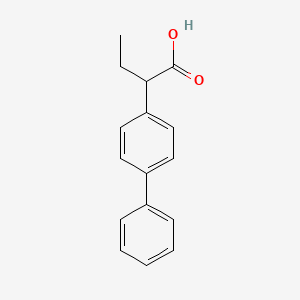

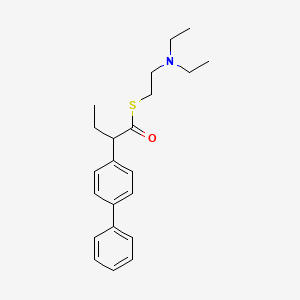
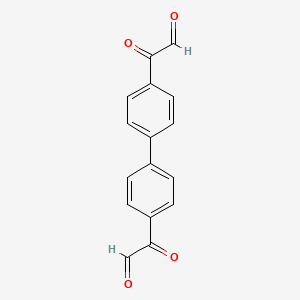
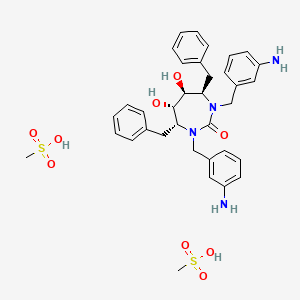
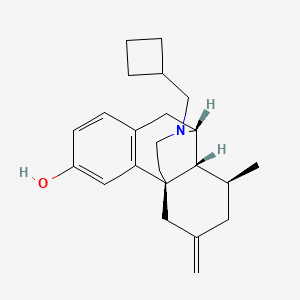


![1-Ethyl-4-[(1E,3E,5E,7E,9E,11E,13E,15E,17E)-18-(1-ethylpyridin-1-ium-4-yl)-3,7,12,16-tetramethyloctadeca-1,3,5,7,9,11,13,15,17-nonaenyl]pyridin-1-ium;dibromide](/img/structure/B1684252.png)
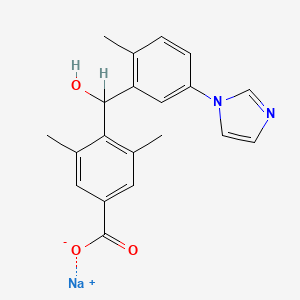
![But-2-enedioic acid;8-(2,3-dihydro-1,4-benzodioxin-3-ylmethyl)-1-thia-4,8-diazaspiro[4.5]decan-3-one](/img/structure/B1684254.png)
